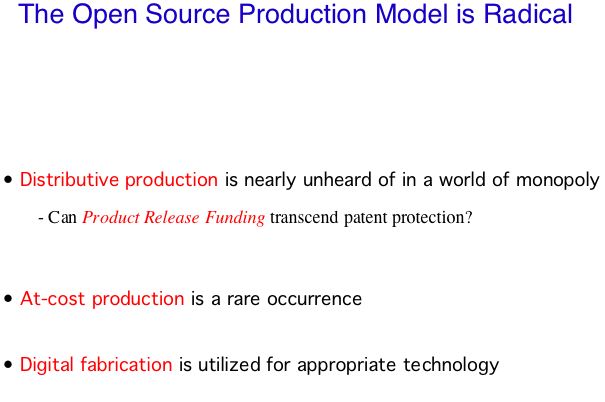Slide 28: Difference between revisions
(New page: Slide 1 - Slide 2 - Slide 3 - Slide 4 - Slide 5 - Slide 6 - Slide 7 - Slide 8 - Slide 9 - Slide 10 - Slide 11 - Slide 12 - Slide 13 - [[...) |
No edit summary |
||
| Line 2: | Line 2: | ||
[[Image:Slide 28.jpg]] | [[Image:Slide 28.jpg]] | ||
---- | |||
To begin summing up, we have a radical business model in front of us. A distributive production model is a welcome guest in a world of monopoly, guarded by patent lawyers and other parasitic behavior. Product Release Funding, as we propose, may become a viable alternative. | |||
At cost production is definitely a welcome addition to any community – and we are showing how that can be done. | |||
And look at this – can advanced technology finally start serving human needs, instead of providing more planned obsolescence products? Digital fabrication is a route to high-tech, appropriate technology – and open design is the only antidote we know of to planned obsolescence. | |||
Revision as of 19:33, 29 April 2008
Slide 1 - Slide 2 - Slide 3 - Slide 4 - Slide 5 - Slide 6 - Slide 7 - Slide 8 - Slide 9 - Slide 10 - Slide 11 - Slide 12 - Slide 13 - Slide 14 - Slide 15 - Slide 16 - Slide 17 - Slide 18 - Slide 19 - Slide 20 - Slide 21 - Slide 22 - Slide 23 - Slide 24 - Slide 25 - Slide 26 - Slide 27 - Slide 28 - Slide 29 - Slide 30 - Slide 31 - Slide 32 - Slide 33
To begin summing up, we have a radical business model in front of us. A distributive production model is a welcome guest in a world of monopoly, guarded by patent lawyers and other parasitic behavior. Product Release Funding, as we propose, may become a viable alternative.
At cost production is definitely a welcome addition to any community – and we are showing how that can be done.
And look at this – can advanced technology finally start serving human needs, instead of providing more planned obsolescence products? Digital fabrication is a route to high-tech, appropriate technology – and open design is the only antidote we know of to planned obsolescence.
